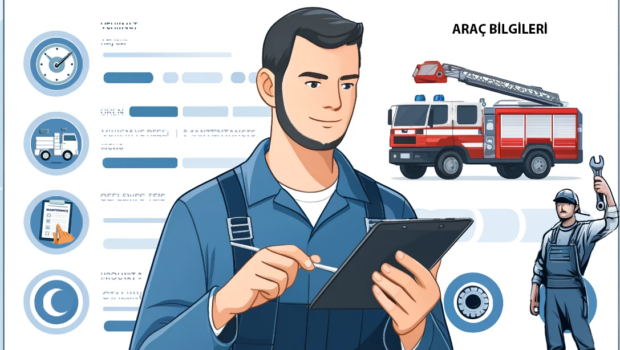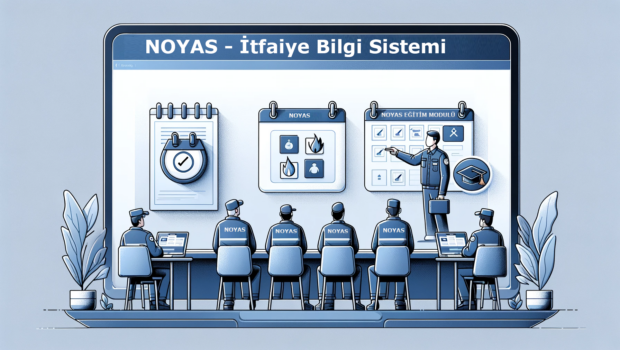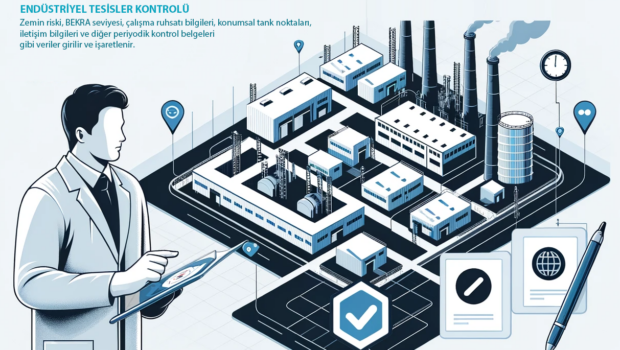Web-Based
NOYAS is a comprehensive information system developed to digitize and optimize firefighting services. Our NOYAS Fire Information System offers various modules and features to make firefighting operations more efficient, faster, and safer.

Web-Based
NOYAS is a comprehensive information system developed to digitize and optimize firefighting services. Our NOYAS Fire Information System offers various modules and features to make firefighting operations more efficient, faster, and safer.

Vehicle Maintenance Module
The vehicle maintenance module manages the processes related to the maintenance and repair of firefighting vehicles. With this module, users can:
Mark faulty vehicles and defective equipment via tablets and list them on the shift supervisor’s screen.
View vehicle information and details of malfunctions, repair them within their unit or forward them to the maintenance department.
Track the list of repaired vehicles and the processes of vehicles sent to the maintenance department.
Select the category and subcategory of the malfunction, enter the details of the repaired malfunction, and the information of the personnel who performed the repair.
Track vehicle inspection and insurance dates, and receive notifications for upcoming dates.

Training Module
The Training Module facilitates the planning and management of training for firefighting personnel and relevant individuals. With this module, users can:
Easily manage certified training requests with an e-Municipality online application infrastructure.
Create training plans by selecting from a form listing individuals and companies requesting training.
View the name of the selected company, the contact person’s name, phone number, title, email address, and company address information.
Enter and update training dates, class hours, training locations, and instructor details.
Add notes about the training and split sessions into groups if class size limits are exceeded.
Change the date, time, location, or instructor of previously planned training groups.
Delete scheduled training or groups.
Merge different individual or company requests for the same training into a single session.
Record the working hours of assigned personnel and display these durations on a monthly calendar.

Industrial Facilities Inspection Module Tablet Application
This module conducts inspections of industrial establishments and fuel stations via tablets. Its features include:
Login with an SMS code and the ability to operate in offline mode.
Save operations offline when there is no internet connection, and automatically send them to the API once connected.
Provide both offline and online map views, displaying institutional map bases and layers.
Display the list of assigned companies, their names, and operation statuses.
Choose between Industrial Control or Fuel Station Control.
Enter and mark data such as ground risk, BEKRA level, operating license information, contact details, and other periodic control documents.
With EBYS integration, you can initiate the signature flow without any printouts!
Mobile Field Application
Mobile application with online and offline features.
Comprehensive Reporting and Statistics
Extensive reports and statistics, including fire types and equipment used, can be obtained.
Calls from 112 can be directly registered into the system. The incident location can be accessed by selecting from the official address system or by clicking on the map.
Once the incident address is determined, the system automatically suggests the nearest station and vehicle information.
The Incident Site Fire Report, which must be provided by the institution, is automatically prepared by the system after being filled in by firefighting personnel according to the institutional template.
Petitions from institutions and organizations requesting a Workplace Fire Compliance Report are recorded in the system. The address is inspected via the tablet application, checking the compliance of items required by the legislation with accompanying photos. The report is then automatically generated.
Extensive reports and statistics, including fire types and equipment used, can be obtained.
Tasks can be assigned to relevant personnel by selecting the vehicle plate. This ensures transparent and organized tracking of task distribution.
This tab plans the vehicle deployment order based on incident types. It sets which vehicles will respond to which incidents to ensure rapid intervention in emergencies.
Incident Type Selection: Determine the type of incident (e.g., Vehicle Fire, Traffic Accident, Animal Rescue).
Plate Selection: Choose the vehicle to be deployed according to the incident type.
This section is for creating and tracking personnel shift schedules.
Start and End Times: Enter the start and end times of shifts.
Assigned Personnel: Select personnel who will be on duty.
Add Backup Personnel: Add backup personnel if needed.
This section defines daily routine tasks and responsibility areas.
Task Selection: Assign tasks like Tea Duty, Internal Services, Radio Operator.
Personnel Selection: Assign suitable personnel to selected tasks.
This module facilitates the planning, tracking, and reporting of daily training activities for firefighting personnel. Developed to ensure the systematic and transparent execution of training processes, it offers detailed control at both instructor and participant levels.
Training Planning and Tracking:
Training Name and Subtitle: Define training titles and content. For example, under FIREFIGHTER SAFETY, cover topics like Safety at Fire Stations.
Theoretical/Practical Selection: Specify if the training is theoretical (T) or practical (P).
Training Duration: Enter the duration of the training sessions.
Training Status Notification:
After completing the training, update the status via “Training Completed” or “Training Not Completed” buttons for easy tracking.
Managing Training Participants:
Shift Selection: Select the relevant shift to identify participating personnel.
Attendance Tracking: View and verify the attendance status of personnel in the selected shifts.
Instructors and Group Supervisors:
Instructor Selection: Assign responsible instructors for the training.
Group Supervisor Selection: Designate the group supervisor to approve attendance. Also, assign deputy supervisors if necessary.
Training Reporting and Submission:
Once all details are entered, save the training information with the “Preview and Submit” button and forward it to higher authorities.
The Activity Report module enables detailed tracking and reporting of all daily tasks and operations carried out by firefighting groups. This system consolidates all automatically and manually recorded activities in a central list for easy monitoring.
Automatic Activity Tracking:
The module automatically records all operations within the firefighting group. For example:
Faults and repairs entered via the Vehicle Maintenance Module are automatically displayed in the activity report.
Any equipment malfunction or repair in the inventory is directly reflected in the report.
Examples:
The fault in the vehicle with plate number xx xx xxx was repaired on 25.07.2024.
The Smoke Extraction Fan (Aspirator) in the vehicle with plate number xx xx xxx is faulty.
Manual Activity Addition:
In addition to automatically recorded activities, users can manually add special cases or additional tasks to the system.
Use the “Add New Activity” button for easy manual entries.
This feature allows for quick reporting of unexpected events or specific field situations.
Fuel Tracking:
Monitor the fuel consumption and refueling processes of firefighting vehicles in this section.
Plate or Group Selection: Select the vehicle or group for fuel tracking.
Fuel Type and Quantity: Enter the type of fuel (gasoline, diesel, etc.) and quantity in liters.
Add Button: Save the entered information to include fuel consumption in the report.
Archive Access:
Easily access past activity reports through the Archive section in the left menu. This allows for retrospective review of previous tasks, faults, and maintenance history.
Centralized Recording and Monitoring: All tasks and activities are consolidated in one module to prevent confusion.
Time-Saving: Automatic data integration minimizes manual data entry.
Transparency and Auditing: Every performed task is recorded, facilitating auditing processes.
The Material Request Module ensures the systematic request, tracking, and archiving of materials needed by firefighting personnel. By managing both individual and group-based material requests through a central system, this module speeds up the process and enhances transparency.
Managing Incoming Requests:
The incoming requests list is a central panel that consolidates all material needs.
Request Type and Personnel Selection: Filter requests by type and the requesting personnel.
Date and Quantity Information: View requests within specified time frames by start and end dates.
Detailed Viewing: Examine request details with the “Show Request Details” button.
Personal Protective Equipment Request:
Used for meeting individual protective equipment needs of firefighting personnel.
Material Selection: Choose protective equipment like Nomex Suits, Fire Gloves, THSC Masks.
Quantity and Purchase Type: Specify the requested amount and purchase type (e.g., replacement).
Intervention Material Request:
This section handles requests for special equipment used during interventions.
Material List: Select intervention equipment like Halligan Tools, Hydrant Keys, Fire Water Intake Valves.
Unit and Approval Process: Select the requesting unit and complete the process with the approval of the shift supervisor or intervention branch manager.
Group Material Request:
This section manages material requests for common use within firefighting groups.
Category and Material Selection: Choose materials based on categories like cleaning supplies (e.g., Tea, Glass Cleaner, Vehicle Washing Brushes).
Preview Requests: After entering requests, “Preview” and approve them in the system.
Maintenance-Repair Material Request:
Request materials needed for equipment maintenance and repairs.
Material Selection: Choose maintenance equipment like Chainsaw Chains, Chargers, Diesel Filters.
Approval Process: Complete the request process with the approval of the shift supervisor or manager.
Fuel Request:
Handles fuel needs for vehicles.
Fuel Type and Quantity Information: Select fuel types like gasoline and diesel, and enter the required amount.
Archive and Tracking:
All material requests are archived, and past requests can be easily viewed.
EBYS Status: Monitor the status of requests in the electronic document management system (EBYS) (e.g., In Process, Signed).
File Access: Directly access PDF documents related to the requests.
Advantages
Centralized Management: Manage all material requests through a single system to simplify process control.
Fast and Easy Request Process: Quickly enter and track requests with a simple, user-friendly interface.
Transparency and Easy Tracking: All requests are archived, and each stage of the process is transparently monitored.
Approval Mechanism: Requests are controlled through approval processes by shift supervisors and managers.
The NOYAS Fire Information System aims to enhance operational efficiency and safety by digitizing firefighting services. From training modules to vehicle maintenance, industrial facility inspections to e-petitions, it offers a wide range of solutions. These modules facilitate firefighting teams’ workflows, enabling faster and more effective interventions.
By defining urban and rural areas as closed spaces, the system automatically determines the type of incident location, providing much more accurate reports.
Transfer information to decision support mechanisms with much more statistics.